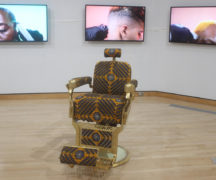By DAVID DUPONT
BG Independent News
Michael Harris settled comfortably on the couch in the lounge that serves as home base for Bowling Green State University’s Arts Village in the basement of Kreischer Compton dorm.
The 1971 BGSU graduate remembers the dorm well from his student days. His girlfriend lived in the dorm, and she became his wife, then his ex-wife.
Looking around campus, Harris said, he saw a lot that hadn’t changed, including the School of Art where he studied with Bob Mazur, Willard Wankelman and Paul D. Running, and the baseball diamond where he played ball.
He was the only black on the team, he recalled, and one of fewer than 100 African-Americans in the student body.
Harris came back to campus last week as the keynote speaker for the Africana Studies Student Research Conference. His speech was on “Conjuring an Africana Aesthetic,” but now the talk was less formal.
A handful of students spread through the launch as his host at the Arts Village art professor Joel D’Orisio occasionally asked a few questions.
Harris lived in Harshman, which he was advised he better go see because it was slated to be razed.
Harris said he found BGSU much improved from when he was here. He helped found the Black Student Union. Now there were offerings in ethnic studies that would have “brought tears to my eyes back then.”
He’d come to BGSU hoping to escape the racism of his native Cleveland. Racism that left innumerable “papercuts and bruises” on his psyche.
At BGSU though he couldn’t readily hear the music he grew up on.
When he took an African history course it was all about Stanley Livingston and the white colonizers and the treaties they used to divvy up the continent among themselves. Students didn’t learn about any Africans. Harris intended to be an English major, but he had antipathy toward 19th Century English literature, and “I didn’t get Shakespeare at the time,” he said. “African-American writers weren’t being highlighted.”
Now the diversity of student population and the offerings “make this pretty nice,” he said.
From BGSU, Harris went on to study art, art history and African American studies at Howard University and then Yale. Now on the faculty of Emory University, he built a distinguished career both as an artist and as an art historian. He’s been called one of the top scholars in his field and is an author of several books including the award-winning “Colored Pictures: Race and Visual Representation.” All that started at BGSU.
He noted as he walked past the display of photographs of Arts Village students, past and present. This reminded him of The Wall of Respect, a mural created by AfriCOBRA, an Chicago arts collective. The mural celebrated activists, athletes, writers and musicians. Its significance has outlasted its short life. Painted in 1968, the building it was on was torn down by the Daley administration after a fire in 1971.
“When Fascists get in power one of the first things they do is destroy the arts,” Harris said. “People don’t realize how powerful the voice of the artist is” in maintaining a sense of integrity. And artists themselves “often don’t realize the power we have in our hands.”
Harris joined AfriCOBRA in 1980.
This sparked a conversation with Yusuf Lateef, a graduate art student who has been working on murals in Toledo. “I’m a muralist,” Lateef said. “I want to engage in the space.”
Harris said communities take a sense of ownership of the murals. The AfriCOBRA movement even restricted who could photograph the murals.
Lateef said he sees creating a mural as a performance that’s “at the heart of the practice.” He wants people see him working to add to the community.
He asked Harris his opinion of Kehinde Wiley, the art world superstar who is now the focus of a retrospective at the Toledo Museum of Art.
Wiley interjects contemporary figures, people he selects from the streets, into the context of 19th century European paintings. His subjects are dressed in the latest urban style. Harris said Wiley’s injecting black figures into traditional European art tends to reinforce the dominance of the traditional canon.
Harris said he would rather see the canon expanded to include more work that draws on African and black forms.
This is mission Harris has been on since he studied Yoruba art as a graduate student. It has infused his work as a scholar and an artist.
The two sides of his career inform each other. He works in several media. His art “reflects the world I have been part of,” he said.
“I’m just trying to grab it as it comes,” he said. He does not create with a fixed idea in mind. “I can’t wait to see what it looks like when it’s finished.”


